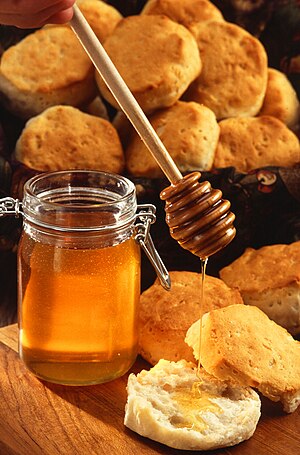 |
| Honey (Photo credit: Wikipedia) |
-----
BY PETER ANDREY SMITH
SAVANNAH, Georgia – There are three vials filled with a sticky, yellowish substance here at the United States Customs and Border Protection’s laboratory. Honey, or so an importer has claimed.
The task: Determine whether the samples are adulterated with sweeteners or syrups, and, if they really are mostly honey, figure out where it originated. If the honey comes from China, often the case, the entire shipment may be subject to additional taxes.
Honey has been a focal point for the lab and the source of a long-running international food scam –known as honey laundering – that has challenged even the existing forensic technology.
Some 70 percent of the honey consumed in America is imported. In 2001, the Commerce Department enacted a stiff tariff on Chinese honey after American producers complained that Chinese competitors were dumping their products on the market.
Then, honey imports from other countries spiked, including from nations not known for large bee populations. According to the American Honey Producers Association, Malaysian beekeepers, for example, have the capacity to make about 20,000 kilos of honey annually, but the country has exported as much as 17 million kilos of honey to the United States in a year.
In an effort to stanch the flow of illicit honey, chemists here have tested thousands of samples from ports across the Southeast. In 2008, the lab demonstrated with about 90 percent accuracy that honey imported from Thailand, the Philippines and Russia had originated in China.
Robert Redmond and Christopher Kana, two of the lab’s chemists, recently took a honey sample and added an acid to digest it. The result looked like muddy water.
Scientists recently have demonstrated that subtle chemical variations in many foods, including honey –undetectable to the tongue or the naked eye – can give a strong indication of where it originated. The lab’s analytic work depends on these geographic “tracers.”
Once a sample is diluted, the liquid is pumped into a device called a mass spectrometer. Inside, a nebulizer turns the sample into a fine mist over heated argon, a process that yields a distinct signature of trace elements.
The spectrometer can measure chromium, iron, copper and other elements to several parts per quadrillion. Each combination reflects the composition of soils: The elements were taken up by flowering plants and foraged by bees.
Soils vary by region, and by statistically comparing the presence of some 40 different elements to a reference database, the Customs agency scientist can ascertain the probable origins of samples.
At first, the detection of transshipped honey relied on a simple test for an unapproved antibiotic, chloramphenicol, discovered in Chinese honey. Carson watts, former director of the lab in Savannah, said the Chinese quit using it when “word got out.”
Around 2006, some importers appeared to be cutting honey with high-fructose rice syrup or disguising cheap, pure honey as an artificial blend. (At the time, the import duty applied to artificial blends that were more than 50 percent honey by weight.)
The problem? Reliably determining the ratio of rice syrup to honey is nearly impossible.
“An importer could present goods to Customs and say, ‘This is 90 percent rice syrup, 10 percent honey,’ and Customs really has no way of knowing,” said Michael J.Coursey, a lawyer who has represented American honey producers.
In 2011, the government accused three companies of importing millions of dollars’ worth of rice fructose blend that was mostly honey. The importers said the product was less than 50 percent honey. The scientists in Savannah produced evidence that pollen in the blends showed the substance to be mostly honey. But defense lawyers challenged the research on scientific grounds. The case was dismissed.
The most sophisticated chemical analysis may have its limits. But for the moment, the food detectives are undeterred. Mr. Redmond said, “If it’s honey from Malaysia, then we’re testing for China.”
Taken from TODAY Saturday Edition, The New York Times International Weekly, 31 January 2015

















